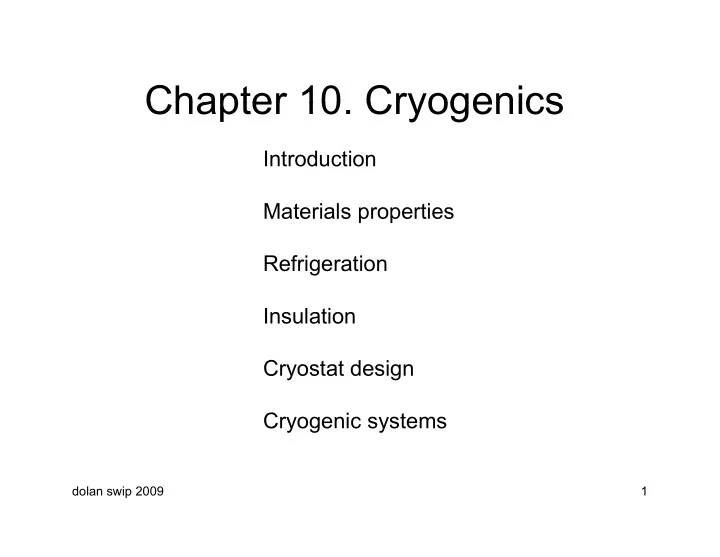

Chapter 10 Cryogenics Chapter 10. Cryogenics Introduction Materials properties Refrigeration Insulation Insulation Cryostat design Cryogenic systems dolan swip 2009 1
Introduction "cryo" cryo cold = cold "genes" = that which generates 1877 90 liquefaction of N 1877-90 liquefaction of N 2 , O 2 O 1892-98 Dewar invented vacuum flask liquified H 2 1908-11 H.K. Onnes liquefied He, discovered superconductivity 1934 Kapitza He liquefaction engine 1947 S.C. Collins liquefaction process dolan swip 2009 2
Applications of Cryogenics Applications of Cryogenics Industrial gas production Food preservation Food preservation Biomedical applications Bearings Electronics El t i Motors and generators Physics research Space technology Fusion research Magnets Magnets Neutral beams Vacuum pumps dolan swip 2009 3
Mechanical Properties Percent Elongation Elongation Mechanical ductility ductility yield stress modulus of elasticity f ti fatigue life lif Failure of welds at low T. “Ductile-to-brittle Transition temperature” dolan swip 2009 4
Thermal Properties Specific heat (J/mole-K): R = 8 314 J/mole-K R = 8.314 J/mole-K D = Debye Temperature D At T < 0 08 At T < 0.08 D , C = 233.8 (T/ D ) 3 Stainless steel St i l t l T(K) C (J/kg-K) 293 476 77 159 20 4.6 dolan swip 2009 5
Thermal Properties T Enthalpy h = h o + dT C(T) o 0 Heat added per kg to raise temperature: T 2 T 2 W/M = dT C(T) = h 2 – h 1 T 1 Example: A coil contains 100 tonnes of Cu stabilizer. A il t i 100 t f C t bili E l If the coil energy of 0.9 GJ is dissipated by a quench, By how much does the Cu temperature rise from 4 K? h = 0.9x10 9 J/10 5 kg = 9000 J/kg = 9 J/g Interpolating in Table we find T = 93 K Interpolating in Table, we find T 93 K. dolan swip 2009 6
Enthalpy vs. Temperature dolan swip 2009 7
Thermal Conductivity structural supports coil outside: d desire low k i l k Strength /k relative to SS-304 relative to SS 304 dolan swip 2009 8
Thermal Expansion Example: SS-304, 4 K 300 K L/L ≈ 0.00303 Need to compute thermal stresses. dolan swip 2009 9
Thermal Emissivity Used for radiant heat 293 K transfer in cryostats dolan swip 2009 10
Electrical Resistivity D Depends on d purity B & radiation damage dolan swip 2009 11
Vapor Pressures of Fluids From H. Neumann, FZK Summer School, 2008 dolan swip 2009 12
Cryogenic Liquids Cannot be liquefied above “critical temperature”. How separate O 2 from N 2 ? dolan swip 2009 13
Refrigeration and Liquefaction Joule-Thomson Effect: If T<T inversion , then If T T inversion , then expansion cooling T T inv (H 2 ) = 204 K (H ) = 204 K T inv (He) = 20 K require precooling dolan swip 2009 14
Expansion Engines Ordinary expansion raises entropy, wastes energy Slow expansion into engine (piston or turbine) cooling with less entropy rise, more efficient. cooling with less entropy rise, more efficient. dolan swip 2009 15
Collins Refrigeration System 25% 29K 50% 8K 25% 12% dolan swip 2009 16
Insulation dolan swip 2009 17
Heat Conduction Example dolan swip 2009 18
Convection and Radiation Small cells (styrofoam) or vacuum convection R di ti Radiation Stephen-Boltzmann Constant: = 5.67x10 -8 W/m 2 K 4 Multilayer radiation barriers: 10 shields with e = 0.20 P rad = 0.003 as large P rad ≈ k app A(T 2 -T 1 )/L dolan swip 2009 19
Apparent Mean Thermal Conductivity 300K 77K Optimum spacing ~ 1 layer/mm Compaction k app app dolan swip 2009 20
Vapor Shielding 293 K 77 K vapor LHe, 4.2 K LN 2 dolan swip 2009 21
Cryostat Design 77 K Support JxB and gravity forces, low heat leak Styrofoam 77K 293 K Styrofoam 77K 293 K dolan swip 2009 22
Heat Inflows 16 TF coils B max = 12 T = dolan swip 2009 23
Superinsulation Installation Poor Better Best Best From H. Neumann, FZK Summer School, 2008 dolan swip 2009 24
Liquid Nitrogen Storage Dewar From H. Neumann, FZK Summer School, 2008 dolan swip 2009 25
MFTF-B Cryogenic System During quench 10 m 3 LHe 7000 m 3 gas 3 recovery bags. dolan swip 2009 26
MFTF-B Cryogenic System 7 struts Diameter =27cm Thickness =2.9cm Each ~ 8 W dolan swip 2009 27
MFTF-B Cryogenic Systems Thermal stress limits cooling rate: 80K 4K takes ~ 4-5 days. dolan swip 2009 28
Summary Cryogenic systems have many applications (industrial, food, biomedical, mechanical, electrical, physics, space, fusion). physics, space, fusion). Materials properties at low T limit performance (mechanical thermal electrical) (mechanical, thermal, electrical). Refrigeration technology well developed, but expensive. About 300 W input power per W of heat removed at 4 K. Multilayer aluminized plastic films in vacuum low k app Multilayer aluminized plastic films in vacuum low k app Structure dominates heat inflow. dolan swip 2009 29
dolan swip 2009 30
Recommend
More recommend